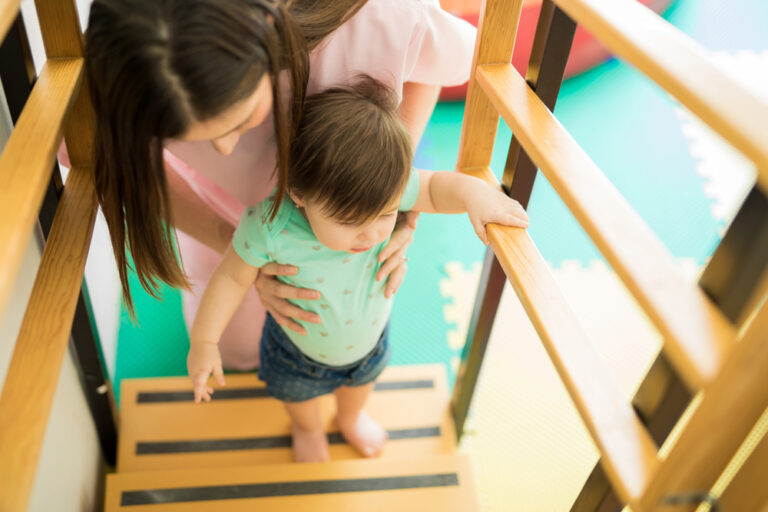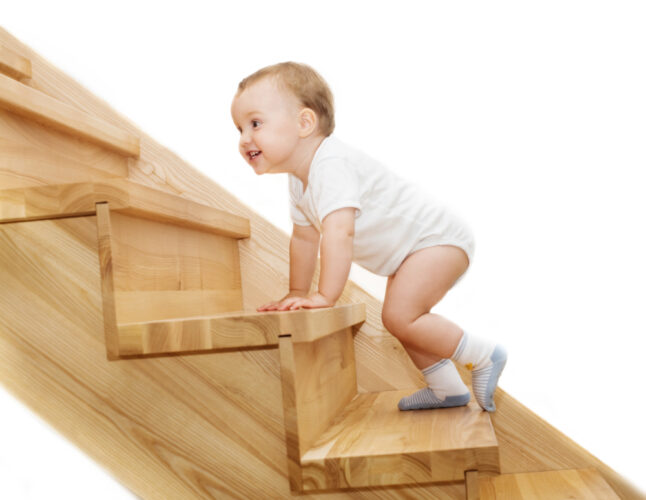According to experts, a child falls down the stairs once every six minutes in the United States, and it’s one of the top causes of childhood injury.
By being proactive and jumping on stair safety from the beginning, you will have more peace of mind when the time comes for your child to use the stairs.
Keep reading for the 3 best ways to teach a baby to climb down stairs safely.
Basic Stair Safety
It’s important to start your journey with safe stairs.
Baby-proof the top and bottom of each staircase prior to your little one being on the move. While you don’t want to make stairs a forbidden part of the house that becomes extra enticing to your little one, you do want to make sure that no accidental falls happen if you’re not right there.
In addition to safety gates at the top and bottom of stairs, the Academy of Pediatrics also recommends removing any toys or tripping hazards, keeping staircases well lit, not allowing your child to carry anything, and encouraging the use of handrails.
As you’re practicing learning to climb stairs, allowing your child supervised access to just three steps is a perfect amount to get started with. Once they become confident navigating three stairs you can make the whole staircase available, again under direct parent supervision.
RELATED: Babyproofing Stairs Without a Railing
Method 1: Scooting Down Stairs
One safe way to navigate getting down a flight of stairs is by having your baby sit feet facing forward, and scoot down each step on their bottom.
We recommend starting at the bottom step and practicing scooting down just one step at a time. You can either sit behind your baby and help encourage them to scoot, or you can stand in front of them and hold their hands as you help them ease down.
Once they are comfortable scooting down a step, gradually increase how many steps up you go, allowing them to practice bumping down multiple steps in a row.
Using a removable gate to block the staircase while leaving the last 3 steps exposed is a great way to limit how many stairs your baby has access to.
Method 2: Going Backwards Down Stairs
Teaching your baby to go climb downstairs backward is one of my favorite methods. It’s what we used with both of my kids before they were confident walkers.
After crawling up the stairs, keep your baby in the same position, and help them climb down in reverse. I don’t recommend having them slide on their belly because momentum could take over. However, encourage using the same climbing motion to come down one step at a time.
You should place yourself behind your baby so you can quickly intervene if they slip or start to stumble.
Similar to the scooting method, if you are able to leave just the last three steps accessible the smaller learning environment is ideal.
Method 3: Walking Down Stairs
Most babies have turned into walkers around 12-18 months. At this point walking down the stairs may be their preferred method.
Because babies like to imitate what they see, they may be anxious to walk the stairs just as you do. As with the first two methods, we recommend starting with just the last few steps.
Encourage your little ones to hold onto the railing or wall for balance. Slow and steady, practice going one step at a time.
Try to eliminate any distractions so that your baby is really focused on the task at hand and make sure to stay close by, most likely in front of them to quickly catch any falls.
Now Practice Going Up and Down
Around 9 months of age, most babies are able to start climbing up small steps. By practicing going up and down, you can help develop their gross motor and large muscle skills in a safe environment. The more you practice these skills the more control they will have as they learn to navigate stairs safely.
Learning to climb up is typically mastered before climbing down, so don’t worry if your baby does not immediately have the coordination to master both. As babies get older and their curiosity takes over they’ll quickly be trying to climb every piece of furniture they can find!
Practice until your baby has perfected the art of stair climbing. Practice on stairs inside at home, up and down on a step stool, outside at the playground, at friend’s houses when you visit, or even if you’re out running an errand. Practice makes perfect, and trying multiple different types of stairs in a variety of settings will allow your baby to really hone their skills.
Even with all the practice, don’t let your guard down. Make sure that all stairs are securely baby-proofed unless you are in direct supervision of your baby.
FAQ’s About Teaching Your Baby to Climb Down Stairs
At What Age Can Babies Climb Stairs?
Typically by around 9 months, babies are starting to climb. However, they will master the art of climbing up before climbing down.
Each baby is different, so watch their gross motor development for when they show signs of being ready.
By 10-12 months they will most likely be able to crawl or climb the stairs with support. Likely by 18 months, they will be ready to be walking stairs, although you and they may still be more comfortable with scooting to going down the stairs backward.
What is the Best Type of Gate to Use on Stairs?
For stairs, we really recommend a gate that can be hardware-mounted directly onto a wall or doorframe, rather than pressure-mounted.
You want a gate that you are confident is fully secured and cannot be knocked over or pulled down by a curious baby. Security is especially important when a flight of stairs is what lies on the other side.
Measure your stairway, and choose a gate specific to banisters if you have a handrail that may make things more confusing.
If you’re looking for the top-recommended baby gates for a safe home, we’ve got you covered!
Final Word
Stairs can be a nerve-wracking obstacle for parents of curious babies. It’s important to make sure that they are secure at all times.
However, it’s equally important to help your baby learn how to safely navigate stairs.
There are many methods that you can use to help your baby get comfortable as they develop their gross motor muscles and gain comfort and control of their body. Stay patient and calm and your baby will, too!







